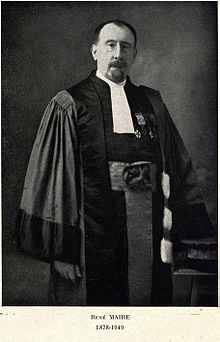René Maire

René Charles Joseph Ernest Maire (29 May 1878,
Biography
His botanical career began very early. At 18, he penned a work on the local flora of the
Named species
Among species he named or renamed are:
- Amanita codinae (Maire) Singer
- Argyrocytisus battandieri(Maire) Raynaud
- Campanula monodiana Maire
- Gymnopilus sapineus (Fr.) Maire
- Hygrophoropsis aurantiaca (Wulfen: Fr.) Maire
- Hygrophorus reai Maire
- Hypomyces vuilleminianus Maire
- Laccaria bicolor (Maire) P.D. Orton
- Lentinellus vulpinus (Fr.) Maire & Kühner
- Psathyrella candolleana(Fr.) Maire
- Psathyrella hydrophila (Fr.) Maire
- Xeromphalina campanella (Bataille: Fr.) Maire & Kühner
He also erected the family Paxillaceae, noting its affinities with boletes, in 1902, based on anatomical similarities.[4] This was confirmed many years later by molecular studies firmly placing the genera Paxillus and Gyrodon at the base of the clade containing the members of the genus Boletus.[5]
Legacy
The French Academy of Sciences awarded him the Prix Montagne for 1903.[6]
Several species were named in his honour, including fungi, such as the beechwood sickener (
Species names for Maire typically end in mairei.
See also
Notes
- ^ René Maire, allocution de M. Edmond Sergent[permanent dead link]
- ^ National Botanic Garden of Belgium (2007). "Collectors for the Herbarium of the National Botanic Garden of Belgium - MAIRE". National Botanic Garden of Belgium website. National Botanic Garden of Belgium. Archived from the original on 2011-07-18. Retrieved 2008-03-12.
- ^ a b Fleur, Elie (1935). "Cent ans d'activité scientifique [A hundred years of scientific activity]". Bulletin de la Société d'histoire naturelle de la Moselle (in French). 34: 54.
- ^ Maire, R (1902). "Recherches cytologiques et taxonomiques sur les Basidiomycetes". Bull. Soc. Mycol. Fr. (in French). 18 (supplement): 1–212.
- PMID 10620406. Archived from the original(PDF) on 2006-02-19. Retrieved 2008-03-11.
- ^ "Séance du 21 décembre". Le Moniteur Scientifique du Docteur Quesneville: 156–157. February 1904.
- ^ Lumbsch TH, Huhndorf SM. (December 2007). "Outline of Ascomycota – 2007". Myconet. 13. Chicago, USA: The Field Museum, Department of Botany: 1–58. Archived from the original on 2009-03-18.
- ^ Tulloss, Rodham E. (2004). "Amanita mairei Foley "René Maire's ringless Amanita"". Studies in the Genus Amanita Pers.(Agaricales, Fungi). Retrieved 2008-03-12.
- ^ Chinese plants with the same epithet were named for Edouard Ernest Maire, 19th century missionary in Yunnan, China who collected many specimens there.
- ^ "Mairetis I.M.Johnst. | Plants of the World Online | Kew Science". Plants of the World Online. Retrieved 17 May 2021.
- ^ International Plant Names Index. Maire.
